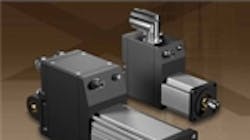Design by objective: Torque and Force
Power-dense actuators suit linear and rotary applications
Tritex II dc-powered actuators combine power and control electronics with brushless servomotors and actuators in a compact package. With continuous force of 1,000 lb, speeds to 33 in./sec, and 12 to 48 Vdc operation, the actuators come in two styles: Linear units employ roller screw technology to convert rotary to linear motion in 60 and 75-mm frame sizes with 75 to 450-mm stroke lengths. Rotary units in 60 and 90-mm frame sizes output up to 4,696 lb-in.
Exlar Corp.
(952) 500-6200
exlar.com
Linear motor offers submicron resolution
The S605 Linear Shaft Motor offers acceleration force between 1,000 and 3,100 N and continuous force from 420 to 780 N. Available in three windings (double, triple, or quadruple), its shaft diameter is 60.5 mm; output stroke lengths are between 200 and 2,000 mm. Other features include continuous current between 8.4 and 8.8 A, a noncritical airgap of 1.75 mm, and rated voltage of 240 V.
Nippon Pulse America Inc.
(540) 633-1677
nipponpulse.com
Rod-style actuator features high force, small package
The IMA55 high-force servo linear actuator is now available with an optional roller screw that boosts thrust capability to 30,470 N. In addition, a compact IMA22 actuator has been added to the line; it features a ballscrew and delivers force to 1,446 N. Available in four sizes, the IMA line of integrated-motor rod actuators output stroke lengths from 76.2 to 457.2 mm at speeds to 610 mm/sec. The design
enables easy screw relubrication without disassembly.
Tolomatic Inc.
(800) 328-2174
tolomatic.com
Supersize torque limiters minimize downtime
The Torque Limiter product line now includes extra-large models for handling up to 37,000 lb-ft of torque, designed to protect drive trains, gearboxes, and generators from excessive peak loads. Limiters minimize the risk of breakdowns and costly repairs while extending system life. Features include factory preset torque, maximum bore sizes to 5 1/2 in. with or without keyway, and operating temperatures from -40° to 80° C. Custom units are also available.
Zero-Max Inc.
(800) 533-1731
zero-max.com
Planetary gearbox maximizes torque density
G30A planetary gearboxes complement five series of Pittman motors, allowing a wide range of output torques and speeds. The mounting profile is 30.5 mm in diameter or 38.0 mm square when an optional mounting flange is used. Gearbox lengths measure 33.7 to 51.2 mm, while 14 standard reduction ratios from 4:1 to 1,296:1 allow maximum torque output of 2.47 to 8.83 Nm. Sintered steel planet gears promote high torque capacity and low noise in a compact design.
Pittman, AMETEK Precision Motion Control
(267) 933-2105
pittman-motors.com
Linear actuators solve candy conundrum
The task of turning sugar, fruit flavors, cocoa, and other ingredients into various candies is anything but simple, especially when it involves 24/7 automated production. One confectionary OEM — Baker Perkins of Grand Rapids, Mich. — has watched the candy industry evolve over the past century, as it designs and installs high-output equipment. Among the company’s flagship products is its ServoForm depositor, a machine that makes sugar confectionery treats, such as hard and soft candies, lollipops, and jellies.
ServoForm forces syrups through depositing nozzles into molds on a continuously moving conveyor, where candies are cooled and ejected before moving to packaging machines. During a recent technology review, engineers examined the ServoForm and discovered some time-consuming maintenance procedures. For one, each product changeover required two operators to remove and replace a steel washout tray used to collect residual syrup and cleaning water from the previous batch.
“We identified suboptimal operations,” explains Dave Seekins, electrical engineer. “We needed a more hygienic, user-friendly design.”
Automating the washout cycle meant changing the entire depositor head assembly to create enough room underneath to automatically insert a washout tray to collect syrup. To change the head, engineers needed to relocate rotary servos for the pistons, which pump high-viscosity candy through depositing nozzles, from the base of the machine onto the head. The engineers knew this would present problems with weight and machine speed, plus introduce more mechanical hardware above the confections, creating a risk of contamination.
The team considered replacing the rotary servos with linear servomotor actuators to reduce the number of mechanical components. However, they were concerned the linear actuators wouldn’t perform as well as the trouble-free rotary types, and they needed actuators with enough force to pump candy through the nozzles. The mechanical team first redesigned the head to automate washout tray removal and insertion, and then moved on to the actuator question. Motion specialists at Rockwell Automation, Milwaukee, were invited to help develop a prototype to test whether Allen-Bradley MPAI linear actuators were capable of pumping syrup at the required rate and viscosity.
“We provided load figures, and they came back with a proposal. Then we built a demo rig that used an air cylinder system to simulate the load,” says Seekins. “During a three-month test, the prototype completed 10 million cycles. We configured the unit to log power peaks and troughs, stroke count, and current consumption. After the test, we had a good understanding of production capabilities.”
The new machine uses PowerFlex variable-speed drives combined with the MPAI actuators, along with Kinetix servo drives to synchronize movements of the head, pistons, and mold circuit for maximum precision. The servomotor technology offers greater flexibility and control, lowering labor costs and reducing energy bills. All manual operation is eliminated, resulting in smoother startup, shutdown, and delicious confections.
For more information, visit rockwellautomation.com.
